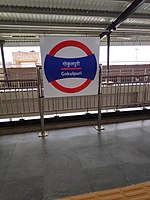The 2020 Delhi riots, or North East Delhi riots, were multiple waves of bloodshed, property destruction, and rioting in North East Delhi, beginning on 23 February 2020 and caused chiefly by Hindu mobs attacking Muslims. Of the 53 people killed, two-thirds were Muslims who were shot, slashed with repeated blows, or set on fire. The dead also included a policeman, an intelligence officer and over a dozen Hindus, who were shot or assaulted. More than a week after the violence had ended, hundreds of wounded were languishing in inadequately staffed medical facilities and corpses were being found in open drains. By mid-March many Muslims had remained missing.Muslims were marked as targets for violence. In order to have their religion ascertained, Muslim males—who unlike Hindus are commonly circumcised—were at times forced to remove their lower garments before being brutalised. Among the injuries recorded in one hospital were lacerated genitals. The properties destroyed were disproportionately Muslim-owned and included four mosques, which were set ablaze by rioters. By the end of February, many Muslims had left these neighbourhoods. Even in areas of Delhi untouched by the violence, some Muslims had left for their ancestral villages, fearful for their personal safety in India's capital.The riots had their origin in Jaffrabad, in North East Delhi, where a sit-in by women against India's Citizenship (Amendment) Act, 2019 had been in progress on a stretch of the Seelampur–Jaffrabad–Maujpur road, blocking it. On 23 February 2020, a leader of the ruling Hindu nationalist Bharatiya Janata Party (BJP), Kapil Mishra, called for Delhi Police to clear the roads, failing which he threatened to "hit the streets". After Mishra's ultimatum, violence erupted. Initially, Hindu and Muslim attacks were equally lethal. Most deaths were attributed to gunfire. By 25 February 2020, the balance had shifted. Rioters wearing helmets and carrying sticks, stones, swords or pistols, and the saffron flags of Hindu nationalism entered Muslim neighbourhoods, as the police stood by. Chants were heard of "Jai Shri Ram" ("Victory to Lord Rama"), a religious slogan favored by prime minister Narendra Modi's party. In the neighbourhood of Shiv Vihar, groups of violent Hindu men attacked Muslim houses and businesses for three days, often firebombing them with cooking gas cylinders and gutting them without resistance from the police. In some instances, Muslims countered perceived threats by returning the violence; on the 25th a Muslim mob approached a Hindu neighbourhood throwing stones and Molotov cocktails and firing guns. During this time, stories were also told of Sikhs and Hindus coming to the aid of besieged Muslims; in some neighbourhoods, the religious communities cooperated in protecting themselves from violence.The Indian government swiftly characterised the violence as spontaneous. The Delhi Police, which is directly overseen by India's central government, moved into the area in strength on 26 February after the Delhi High Court had ordered it to help remove injured victims to hospitals. India's national security advisor, Ajit Doval, visited the area; the prime minister, Narendra Modi, made an appeal for peace on Twitter. The Delhi police were accused by the affected citizens, eyewitnesses, human rights organizations and Muslim leaders around the world of falling short in protecting Muslims. Videos showed police acting in a coordinated manner against Muslims, on occasion purposefully helping Hindu gangs. Witnesses said some police officers joined the attacks on Muslims.After the violence had abated in the thickly-settled mixed Hindu-Muslim neighbourhoods of North East Delhi, some Hindu organisations continued to parade alleged Hindu victims of Muslim violence in an attempt to reshape the accounting of events and to further inflame hostility towards Muslims. About 1,000 Muslims sought shelter in a relief camp on the fringes of Delhi. Gangs of Hindus appeared in several Muslim neighbourhoods in the days preceding the Hindu festival of Holi, celebrated in 2020 on 9 March, to scare Muslims into abandoning their homes. In the midst of prevailing anti-Muslim attitudes, senior lawyers in Delhi were not accepting cases on behalf of the riot victims. Among Hindus and Muslims who continued to live in their neighbourhoods, the violence created potentially long-living divisions. For at least two weeks after the rioting, they avoided each other during the day and at night blocked their lanes with barriers.



